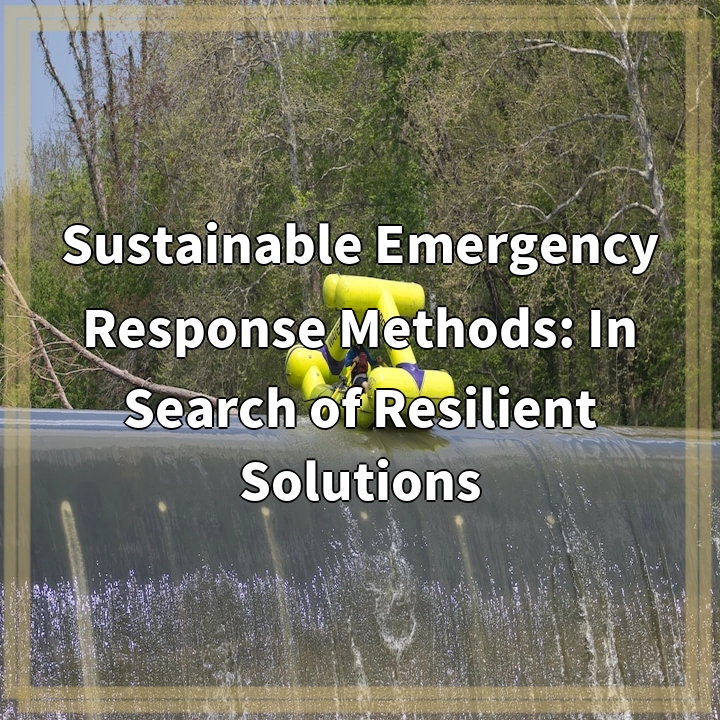
What is Sustainable Emergency Response?
Sustainable emergency response refers to the application of environmentally conscious and resilient methods in addressing emergencies and disaster situations. It encompasses strategies and practices that aim to mitigate the negative environmental impacts, promote long-term sustainability, and ensure the well-being of both human and ecological systems during and after emergencies.
Real-World Problems Associated with Sustainable Emergency Response
1. Limited Resources
In emergency situations, there is often a scarcity of resources such as food, water, energy, and medical supplies. This scarcity can lead to increased environmental pressure and waste generation if not managed effectively. Finding sustainable alternatives or optimizing the use of resources becomes critical when confronted with limited availability.
2. Infrastructure Vulnerability
Many existing infrastructure systems, such as buildings, roads, and utilities, are not designed to withstand extreme weather events or other disasters. This vulnerability can result in significant damage, destruction, and subsequent environmental consequences. Developing resilient infrastructure that can withstand and quickly recover from emergencies is essential in sustainable emergency response.
3. Displacement and Migration
Emergency situations often lead to the displacement of populations and mass migration. This movement can have far-reaching environmental consequences, including increased pressure on host communities and their resources, deforestation, habitat destruction, and biodiversity loss. Implementing sustainable strategies to support displaced populations and manage their impact on the environment is crucial.
4. Pollution and Waste Management
During emergency response efforts, there is a significant risk of pollution and improper waste management. Contaminated water sources, air pollution from burning debris, and improper disposal of medical waste can lead to long-term environmental damage. It is essential to prioritize proper waste management and pollution control measures to minimize the environmental impact.
5. Climate Change Adaptation
Climate change exacerbates the frequency and intensity of many disasters, making preparedness and adaptation crucial. Sustainable emergency response must actively consider and address climate change impacts on vulnerable communities, ecosystems, and infrastructure. This includes incorporating climate change projections and adaptation measures into emergency planning and response strategies.
6. Social Inequity
Emergency situations often disproportionately affect marginalized and vulnerable communities. This can perpetuate social inequities and create additional challenges in achieving sustainable emergency response. Fostering inclusivity, ensuring equal access to resources and services, and addressing social disparities are key considerations in building resilience and promoting sustainability in emergency response.

Solutions for Sustainable Emergency Response
1. Resource Management and Efficiency
Implementing resource management strategies can help optimize the use of limited resources during emergencies. This includes rationing, recycling, and utilizing alternative and renewable energy sources. Efficient use of resources can help minimize waste generation and reduce the environmental impact.
2. Resilient Infrastructure Development
Investing in the construction of resilient infrastructure is crucial for sustainable emergency response. This involves incorporating climate-resilient design principles, using eco-friendly materials, and considering the long-term sustainability of infrastructure systems. Building infrastructure that can withstand emergencies and quickly recover minimizes environmental damage and ensures community resilience.
3. Community Support and Integration
Engaging and involving local communities in emergency response efforts fosters social cohesion and sustainable solutions. Inclusive decision-making processes, community-based training, and education programs can ensure that all segments of society are considered, promoting social equity and reducing vulnerabilities during emergencies.
4. Sustainable Waste Management
Proper waste management is essential in sustainable emergency response. Establishing systems for collecting, treating, and disposing of waste in an environmentally friendly manner helps prevent pollution and minimize long-term damage to ecosystems. Recycling and repurposing materials can also contribute to reducing waste generation.
5. Climate Change Resilience
Incorporating climate change adaptation and resilience measures into emergency response planning is crucial. This includes considering climate projections, implementing nature-based solutions, and promoting sustainable land management practices. By addressing climate change impacts, sustainable emergency response becomes more effective in protecting vulnerable communities and ecosystems.
6. Collaboration and Partnerships
Collaboration between governments, non-governmental organizations, and local communities is vital for sustainable emergency response. Building strong partnerships can enhance coordination, resource allocation, and information sharing, leading to more effective and holistic emergency response strategies.















